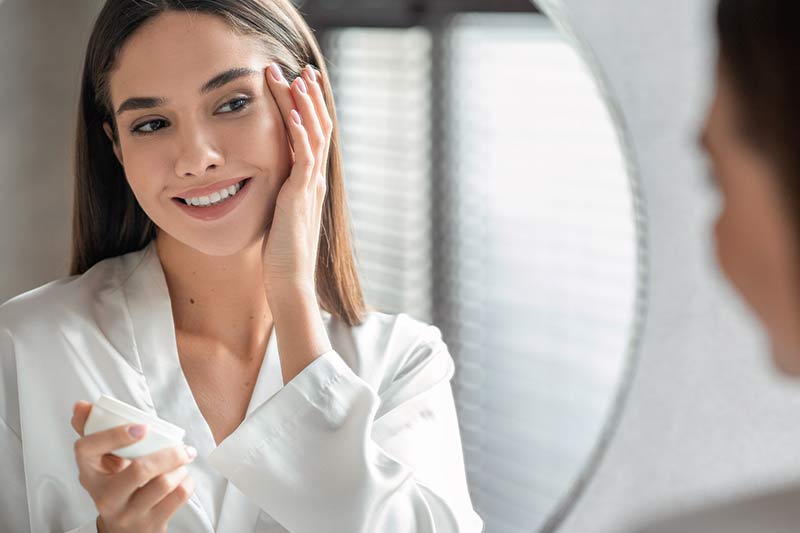A good nighttime skincare routine is more than just a beauty habit—it’s your skin’s chance to repair and renew while you rest. Focusing on cleansing, targeted treatments, and proper hydration can transform tired skin into a glowing complexion by morning. This guide breaks down the essential steps, product types, and tips to help you build a tailored routine for lasting results.
Why a Nighttime Skincare Routine Matters
Think of your skin as having two different jobs. During the day, its main role is defense—shielding you from UV rays, pollution, and other environmental stressors. That’s why morning routines are all about protection, with antioxidants and, most importantly, SPF.
At night, your skin switches from defense to repair mode. While you sleep, your skin’s regeneration process kicks into high gear, working to fix daytime damage, create new cells, and flush out toxins. A dedicated nighttime skincare routine is designed to support this natural process. It cleans away the day’s grime, delivers potent ingredients without interruption from the sun, and provides deep hydration. Consistency here is what leads to real, visible changes in your skin’s health and appearance.
Step 1 – Thorough Cleansing: Removing the Day
Before you can apply any powerful serums or creams, you have to start with a completely clean slate. Simply splashing your face with water isn’t enough to get rid of makeup, sunscreen, and the daily buildup of oil and pollutants. This is where double cleansing comes in.

Why Double Cleansing Is Key
I used to think double cleansing was just a marketing gimmick, but it truly changed my skin. The idea is simple: like dissolves like.
- First Cleanse (Oil-Based): You start with an oil-based cleanser, balm, or micellar water. This first step melts away oil-based impurities like makeup, sebum, and sunscreen. It does the heavy lifting without stripping your skin’s natural oils.
- Second Cleanse (Water-Based): After rinsing off the oil cleanser, you follow up with a gentle, water-based cleanser. This step washes away any remaining residue, along with water-based debris like sweat and dirt. Your skin is left perfectly clean and ready to absorb the products that follow.
Choosing the Right Cleanser for Your Skin Type
The goal is to cleanse thoroughly without making your skin feel tight or dry.
- Dry or Sensitive Skin: Look for creamy, hydrating cleansers or milky lotions that won’t strip moisture.
- Oily or Acne-Prone Skin: Gel or light foam cleansers often work well to remove excess oil without causing irritation.
- Combination Skin: A gentle gel cleanser is usually a safe bet, as it can balance both oily and dry areas.
Step 2 – Preparing Skin: Toners and Exfoliants
Once your skin is clean, the next step is to prep it for treatment. This is where toners and, occasionally, exfoliants come into play.
A toner is no longer the harsh, alcohol-based astringent it used to be. Modern toners are about rebalancing your skin’s pH, adding a first layer of hydration, and sweeping away any last traces of impurities. Look for hydrating formulas with ingredients like glycerin or rosewater.
Exfoliation is the process of removing dead skin cells to reveal brighter skin underneath and help your other products penetrate better. However, this is not a daily step. Over-exfoliation can damage your skin barrier. Stick to 1-2 times a week. Chemical exfoliants like AHAs (glycolic acid, lactic acid) are great for surface texture, while BHAs (salicylic acid) are ideal for getting into pores and helping with breakouts.
Step 3 – Targeted Treatments: Serums and Actives
This is the powerhouse step of your nighttime skincare routine. Serums are concentrated formulas with active ingredients that target specific skin concerns. You apply them to clean, toned skin so they can absorb deeply.
Common choices include:
- Retinol: The gold standard for anti-aging, it helps with fine lines, wrinkles, and skin texture.
- Hyaluronic Acid: A moisture magnet that pulls water into the skin, making it look plump and hydrated.
- Niacinamide: A versatile ingredient that can help with redness, pore size, and oil production.
- Vitamin C: While often used in the morning for its antioxidant properties, it can also be used at night to help with brightening and tackling hyperpigmentation.

How to Use Retinol and When to Avoid It
Retinol is fantastic, but it needs to be used correctly. If you’re new to it, start slow—once or twice a week. You can use the “sandwich method”: apply a thin layer of moisturizer, then retinol, then another layer of moisturizer to buffer potential irritation.
Important: Don’t use retinol on the same nights you exfoliate, as this can be too harsh. And always, always wear sunscreen during the day when using retinol, as it can make your skin more sensitive to the sun. It’s a key ingredient in many products for skincare for over 40s, but it requires care.
Benefits of Hydrating Ingredients (Hyaluronic Acid, Ceramides)
Hydration is everything. Even if your skin is oily, it still needs water. Ingredients like hyaluronic acid and ceramides are essential for this. Hyaluronic acid draws moisture in, while ceramides are fatty acids that help form the skin’s natural barrier, locking that moisture in place. A healthy, hydrated skin barrier means smoother, calmer, and more resilient skin.
Step 4 – Eye Care Essentials
The skin around your eyes is thinner and more delicate than the rest of your face, so it often shows signs of aging or fatigue first. An eye cream is formulated specifically for this area. Gently tap a small amount around your orbital bone using your ring finger (it has the lightest touch) after your serum has absorbed. It helps with hydration, puffiness, and dark circles.
Step 5 – Sealing the Routine: Moisturizers and Night Creams
This is the final, non-negotiable step. A good moisturizer or night cream locks in all the serums and treatments you’ve applied, preventing them from evaporating. It also forms a protective layer on your skin, preventing moisture loss while you sleep.
Night creams are typically richer than day creams because they don’t have to worry about feeling heavy under makeup. In the winter, you might opt for a thicker, richer cream. In the summer, a lighter gel-cream might feel more comfortable.

Common Nighttime Skincare Mistakes to Avoid
We’ve all been there. It’s late, you’re tired, and just want to fall into bed. But a few common missteps can undo all your hard work.
- Skipping cleansing: Sleeping with makeup on can clog pores and lead to breakouts. It’s the biggest mistake you can make.
- Overloading on products: More isn’t always better. Using too many active ingredients at once can lead to irritation. Stick to one or two targeted treatments per night.
- Applying products in the wrong order: A general rule is to apply products from thinnest to thickest consistency (toner -> serum -> moisturizer).
- Being inconsistent: Results come from consistency. Sticking with your routine most nights is what will deliver long-term benefits.
How to Customize Your Nighttime Routine by Skin Type
Your skin is unique, so your routine should be too. Here are a few quick adjustments:
- For Dry Skin: Focus on hydration and nourishment. Use a milky cleanser, a hydrating toner, and a rich, creamy moisturizer with ceramides. Our guide to a skincare routine for dry skin has more targeted advice.
- For Oily Skin: The goal is to balance oil production without stripping the skin. A gel cleanser, a BHA exfoliant (1-2 times a week), and a lightweight, oil-free moisturizer are great choices. For more ideas, check out our dedicated post on a skincare routine for oily skin.
- For Combination Skin: You might need to treat different areas of your face differently. Use a gentle, balancing cleanser and a medium-weight moisturizer. You can apply a hydrating serum to dry cheeks and a niacinamide serum to an oily T-zone. It’s a balancing act, and our guide on a skincare routine for combination skin can help.
- For Sensitive Skin: Keep it simple. Use gentle, fragrance-free products. Introduce new actives one at a time, and always patch-test first.

Final Thoughts
Building the perfect nighttime skincare routine is about consistency, not complexity. You don’t need a dozen steps to achieve healthy, glowing skin. By focusing on the core principles—cleanse, treat, and moisturize—you give your skin the tools it needs to repair itself beautifully overnight.
Listen to your skin, be patient with new products, and enjoy the calming ritual at the end of your day. For more insights, you can find other tips for healthy skin and explore more content on our blog at www.notonetype.org.


You may also like this
Best Skin Care Routine 2025: Step-by-Step Guide
A great skin care routine is the foundation of healthy, radiant skin. Whether you’re new...
Nov
Complete Guide to Building a Skincare Routine for Dry Skin
Dealing with dry skin can feel like a constant battle. That tight, uncomfortable feeling, the...
Nov
Skin Routine for Teens: A Simple Guide to Healthy Skin
Developing a simple, effective skin routine for teens is one of the best things you...
Nov
Balanced Skincare Routine for Combination Skin
Finding the right skin care routine for combination skin means balancing oily zones with dry...
Nov
Best Nighttime Skincare Routine for Oily Skin in 2025
If you have oily skin, the end of the day might feel like a race...
Nov
Skincare for Over 40s: Best Routines, Products & Ingredients for Radiant Mature Skin
Hello, lovely people! Let’s talk about something that feels like it happened overnight: waking up...
Nov